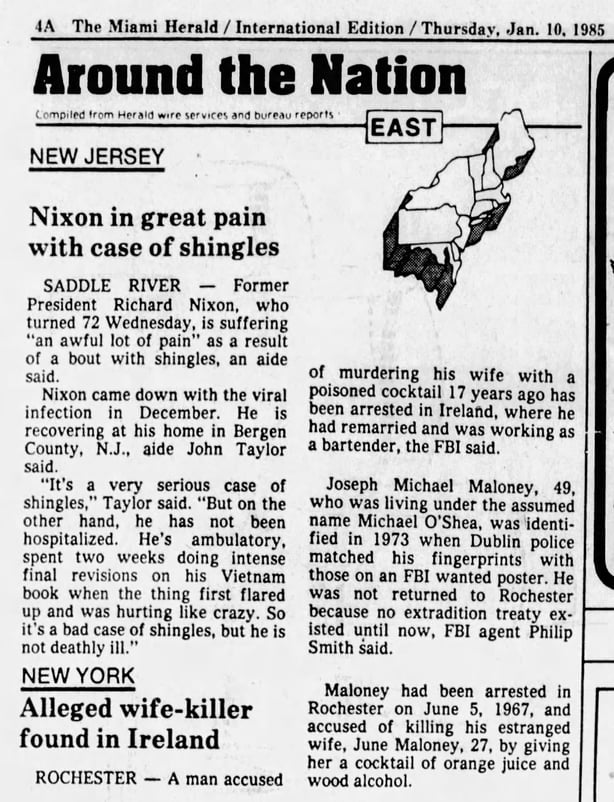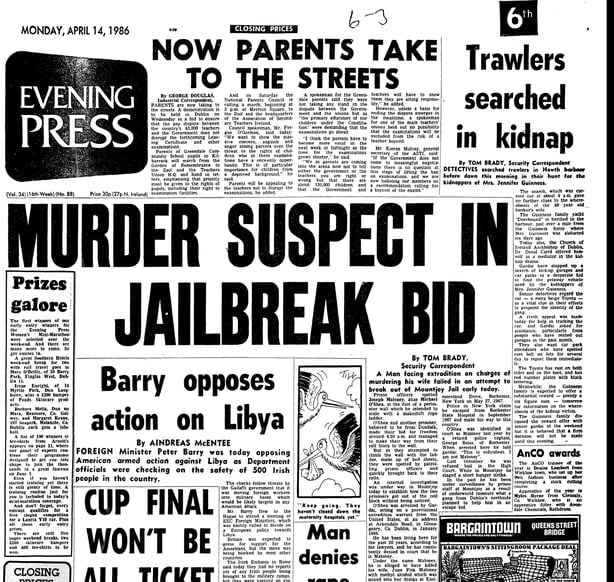Welcome to episode seven of Runaway Joe.
If you are not a religious listener, close this article and open your nearest streaming device before proceeding as things are about to get pretty intense.
Like three attempted jailbreaks, multiple property sales, a maximum security prison and the priest who ordained Sinéad O'Connor intense. So, get comfortable and pay attention.
After being charged with the murder of his wife June, the man whose name gives this podcast its title - Joe Maloney - fled to Ireland to avoid standing trial.
Well, he escaped a mental hospital, the FBI and an army of bloodhounds, but for the sake of brevity let's go with "fled".
He managed to successfully live under the alias of Joe Maloney for nearly 20 years, but a curious Garda Superintendent and dedicated US prosecutor managed to smoke him out.
After decades of hunting this criminal, they finally had him cornered. All it took was a decade and the first extradition treaty between the US and Ireland.
But if everything went to plan for the heroes of this tale this might be the last episode, June’s family might have gotten justice, and Joe Maloney might have spent the rest of his days in a prison cell.
But if you’ve learned anything about this story so far, you know that nothing goes according to plan…
If you have any information or knowledge of Michael O’Shea/Joe Maloney, please send it through to documentaries@rte.ie
Read on for the unbelievable breakdown of episode seven... Jailbreak.
It could happen to a Bishop
Joe Maloney hoodwinked everybody, his friends, his in-laws, his colleagues and even his clergy…
When the late iconic singer-songwriter Sinéad O'Connor became a priest, she was ordained by Bishop Michael Cox of the breakaway Latin Tridentine sect.
Before Bishop Cox knew Sinéad, he had another notable friendship - alleged murdered Joe Maloney.
The clergyman was introduced to Joe (aka Michael O’Shea) in the mid-1970s, and a friendship was born.
Journalist Pavel Barter interviewed the clergyman to discuss what it was like being the chaplain of the escaped fugitive at the centre of this tale.
He would often visit Joe at his stately home Capard, and converse with the German housekeeper, Erika Lotz in her native tongue.
When Joe was arrested in January 1985 for the murder of his wife June, the Bishop was in complete shock.
But that was not the end of their relationship. After all, everyone needs someone to hear their confession…
"From the moment I met the man, you know, he recognised my clergyman status and we actually became friendly, you know, and his wife as well" - Bishop Michael Cox

Phone Calls From Prison
When he was originally incarcerated in Dún Laoghaire Garda station, our fugitive reached straight for the telephone receiver.
Filmmaker Maurice O’Callaghan remembered getting a call from Joe asking him to head down to the station and sort out some legal representation for him, as he had a "problem" - the understatement of the decade.
"Handed me the charge sheet," says Maurice, "and it was laid out that he was charged with murdering his wife and that his name was a completely different name."
Nevertheless, Maurice put him in touch with some barristers in the law library. At this point, he didn’t know what to believe but recalled Joe being inscrutable, calm, and not remotely panicked to him.
Joe then dialled his friend Desmond Fenning, whose daughter Pamela told the podcast, went down to the station with her brother to put bail for Joe. But it was no good the authorities knew who they were dealing with and wouldn’t grant bail to the Fenning’s or Joe’s in-laws.
At this point, Joe started to sweat (finally), so he broke out his contact book and desperately searched for somebody who could secure his freedom.
Everybody we knew who met Michael said no way, he could not have killed his wife. He would never have planned the poisoning that took place - Vanessa Fenning
Watch: Joe Maloney arrested in Dublin - rushes from a 1985 RTE News report
Hunger
Many of Joe’s Irish confidants believed him to be innocent. However, their good opinion wasn’t enough to get him out of Mountjoy as he awaited extradition to the US.
While Joe had a lawyer working on an appeal, he also had an alternative strategy...
Originally, he took the classic approach and tried to break out of jail with some of his old favourites: bribery, explosives and a hidden key. But when that didn’t work out, Joe decided to pursue a more creative route.
Around this time, IRA prisoners in Northern Ireland were using hunger strikes to achieve their political aims. That’s right, Joe engaged in a hunger strike, which authorities believed was another jailbreak scheme. It lasted for seven weeks.
Bishop Cox visited Joe in the hospital at this time. He described the alleged murderer as skeletal and said he refused medical treatment.
"He did refuse treatment," says the Bishop. "And the very words the nurse says, well, Michael, you're in our hospital and we're responsible for treating you. Do you know what he said? "I’ll roll over on my belly and cry like a baby."
But in this instance, history did not repeat itself, and a hospital would not provide Joe Maloney with an escape. Instead, he returned to prison and decided he needed to regroup and start eating again.
He also gave up another act, denying his wife had been murdered. Bishop Cox recounts his colourful confession in this week’s episode, but for that, you need to hit play.
Irish Press, September 24, 1985: Prisoner on fast, is weak. A man wanted by US federal authorities is dying in Mountjoy Jail, it was claimed last night. Joseph Michael Maloney, alias Michael O’Shea, is held in custody until his appeal against extradition to New York is heard in the High Court - Newspaper Report
The Good Wife
Throughout his time, Joe’s Irish wife Sheila Chandler O’Shea stood by him, even when he was refused bail for a second time.
However, the Documentary On One team found evidence while making the podcast that suggested she was completely blindsided by her husband's criminal past and false identity.
While he was in prison, she reached out to his close friends for information about whether the allegations could be true.
She wrote Dr Brian Hanlon, Joe’s friend in Canada, a letter trying to make sense of the situation.
On another occasion, Sheila turned up at the home of Fiona Deverell’s parents (see Episode Six) and asked for their support.
According to Fiona, she was in "floods of tears" and appeared to be shocked by what was happening: "She genuinely believed everything he had told her and she was distraught."
She asked Fiona’s father to buy a car from her so she could gather some cash together. Fiona said her mother felt huge sympathy for Sheila and truly believed she had no idea about Joe’s past.
For all we know Sheila might have been another victim of Joe’s. The team did not find any evidence of physical abuse, but Detective Sergeant Laura Sweeney said domestic abusers rarely stop or change their patterns of behaviour.
"If domestic abuse is in one relationship, it'll be in every single relationship that an offender has. The common denominator is Joe."
"Imagine, if you found out that your husband wasn't who he said he was you probably wonder am I legally married to this person? Am I going to be implicated in what he has done? You know, how have I survived it as well as his wife, when his first wife allegedly he murdered" - Fiona Deverell
Jailhouse Rock
If you thought our criminal was finished with his escape attempts, then you are sorely mistaken. The team tracked down two retired prison guards who worked at Mountjoy during Joe’s stay.
Retired prison guard Sean Reynolds now curates a small museum at the prison; he recalled Joe’s elaborate scheme to break out of Dublin’s Mountjoy.
For his third try at fleeing the Irish justice system, Joe enlisted the help of his younger, fitter cellmate. The day before their jailbreak, his young friend apparently cut the receiver from the lock on the cell door to prevent it from locking.
At 7:30 pm when the other inmates were tucked in for the night, the pair slipped out of their unlocked cell. Mr Reynolds thinks they must have camouflaged their beds. "Like that case in Alcatraz. They must have put pillows in the bed that confused the staff."
They quickly slipped up to the prison attic, through an old window and out onto a roof and then dropped into the outer courtyard.
Then using a makeshift rope that consisted of bedsheets they attempted to scale the prison wall.
While his young comrade managed the task fine, Joe struggled… then a night patrol officer turned the corner to find one convict on a wall and the other trying to scale it.
How did this exchange end? Well, that requires you to start streaming.
The younger man was above on top of it, and he was trying to pull that fellow, the Yank up, and he couldn't get him up - Sean Reynolds

The Luckiest Man Alive
After three failed escape attempts and an extradition treaty to the US signed, sealed and delivered, it looked like the end of the road for Joe. If only...
While FBI agent Gene Harding waited patiently for a call from the Irish authorities to give the green light to send over US marshals to transport Joe Maloney, the universe had other ideas.
Joe was not the only prisoner the US authorities wanted to get their hands on. There were several other Americans from Ireland they were trying to extradite, one of whom challenged the extradition treaty…
The challenge claimed the Irish Government had not acted correctly in funding the treaty - in other words, a legal technicality or administrative error.
In 1986, the Irish Supreme Court declared the extradition treaty between Ireland and the US unconstitutional. And thus thanks to a colossal administrative error, alleged murderer Joe Maloney went free, no jailbreak required.
The FBI, the Gardaí, the DA's office, June’s family and friends watched in horror as years of work, struggle and patience were incinerated due to institutional failure within the Irish Government.
The second Joe exited the High Court after being granted his freedom, he kicked his contingency plan into action. He walked outside, hopped into the car of his friend Rod Fenning and disappeared.
Joe was a free man once more, with roughly £100,000 Irish pounds (€500,000) in his back pocket, thanks to the sale of some assets and the work of his wife Sheila.
Eight months later, in February 1987, the extradition treaty between Ireland and the US was made valid again, but Joe was already gone. His wife Sheila would join in shortly after.
Their whereabouts, unknown…
The treaty, despite the fanfares, was not in Irish law worth the paper it was written on - Michael Woods, Fianna Fáil politician
New episodes of Runaway Joe are available every Friday, from wherever you get your podcasts - catch up here.
If you have any information or knowledge of Michael O’Shea/Joe Maloney, please send it through to documentaries@rte.ie
